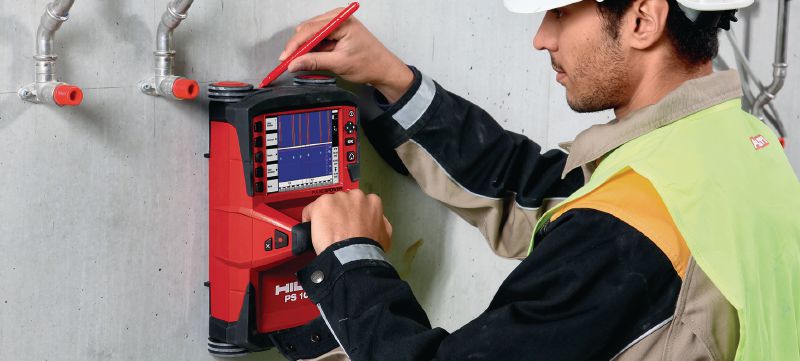Nationwide RainierGPR Service Areas for Advanced Concrete Scanning
Nationwide RainierGPR Service Areas for Advanced Concrete Scanning
Blog Article
Enhancing Job Preparation and Implementation Via Advanced Concrete Scanning Techniques
In the realm of job preparation and foresight, precision and implementation are crucial elements that can make the difference between success and troubles. Advanced concrete scanning methods have actually emerged as an innovative tool readied to elevate the requirements of task management within the building market. By taking advantage of advanced innovation, these techniques use a glance into the architectural integrity of a structure even prior to the first block is laid. The ramifications of such innovations are extensive, promising a standard shift in just how jobs are come close to and provided.
Advantages of Advanced Concrete Scanning Methods

Improved Accuracy in Job Analyses
Enhancing job evaluations with sophisticated concrete scanning methods significantly enhances the precision and integrity of building evaluations. By employing cutting-edge scanning modern technologies such as ground-penetrating radar (GPR) and 3D imaging, task teams can now get detailed insights right into the condition of concrete structures, recognizing prospective defects or weak points that may not show up to the nude eye. This improved degree of accuracy in project analyses enables construction specialists to make even more informed choices concerning repair and upkeep methods, resulting in improved total job results.
Moreover, the increased precision in job assessments achieved through innovative concrete scanning strategies aids in decreasing the threat of unpredicted problems throughout the building and construction stage. By proactively spotting covert anomalies within concrete structures, such as rebar deterioration or spaces, job teams can address these concerns beforehand, staying clear of expensive hold-ups and rework later on in the job lifecycle. Inevitably, the enhanced accuracy in project evaluations facilitated by advanced concrete scanning methods contributes to better efficiency, cost-effectiveness, and high quality in building and construction projects.
Early Identification of Architectural Obstacles
Very early detection of structural difficulties plays an essential function in making sure the honesty and safety and security of concrete structures throughout the construction process. Determining prospective problems at a beginning permits for prompt treatment, protecting against costly rework, schedule delays, and safety risks. Advanced concrete scanning methods, such as ground-penetrating radar (GPR) and 3D imaging, allow task teams to discover surprise defects, spaces, support format inconsistencies, and various other abnormalities that could endanger More Info the structure's stability.
By carrying out these techniques during the planning and execution phases, building experts can proactively deal with structural challenges prior to they rise right into significant issues. For example, finding poor concrete cover over support bars beforehand can protect against deterioration and architectural weakening over time - RainierGPR Service Areas. Additionally, determining variations in concrete density or thickness can assist optimize material usage and ensure uniform strength homes across the structure
Ultimately, early recognition of architectural obstacles with advanced concrete scanning not just improves the general quality and sturdiness of the construction but also adds to a more secure constructed environment for owners and customers.
Boosted Precaution in Building
The implementation of robust safety protocols is critical in the construction market to alleviate threats and protect the well-being of stakeholders and employees. To enhance safety procedures, construction firms are progressively adopting technical improvements such as wearable devices that monitor workers' crucial signs and identify possible wellness problems in real-time. By prioritizing safety and security via the unification of sophisticated innovations and extensive training programs, building and construction jobs can substantially reduce accidents and produce a safe and secure working environment for all included.
Streamlining Task Management Processes
To optimize functional efficiency and ensure project success in the construction market, an emphasis on improving job monitoring procedures is necessary. By carrying out effective task monitoring procedures, building and construction jobs can minimize hold-ups, minimize expenses, and boost total productivity. One key facet of enhancing task management is the usage of sophisticated innovations such as Structure Details Modeling (BIM) software program, which enables real-time cooperation, clash discovery, and precise task scheduling. Furthermore, the fostering of cloud-based task management systems enables smooth interaction amongst employee, instantaneous accessibility to project data, and the ability to track progress in real-time.

Final Thought
In conclusion, the usage of advanced concrete scanning strategies offers various advantages for job preparation and execution. These strategies supply better accuracy in job analyses, early identification of structural obstacles, enhanced precaution in building, and streamlined job monitoring processes. Incorporating these techniques into job operations can inevitably cause much more effective and effective outcomes in building and construction tasks.
Inevitably, the boosted precision in project assessments facilitated by sophisticated concrete scanning techniques adds to better effectiveness, cost-effectiveness, and top quality in building tasks. RainierGPR Service Areas.
To enhance functional effectiveness and make certain click over here now task success in the construction market, a focus on improving task monitoring processes is essential. By carrying out reliable task administration processes, building jobs can lessen hold-ups, minimize expenses, and boost overall efficiency. By streamlining job administration procedures with innovation assimilation, clear communication, and data-driven approaches, construction jobs can achieve greater performance, cost-effectiveness, and effective end results.
These methods offer better precision in task analyses, early recognition of architectural difficulties, enhanced safety and security actions in building and construction, and structured job monitoring procedures.
Report this page